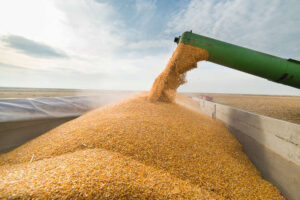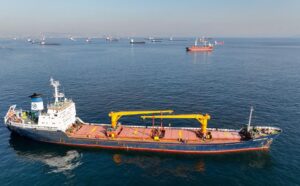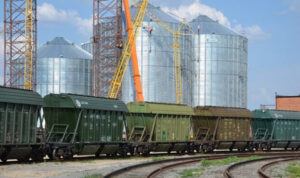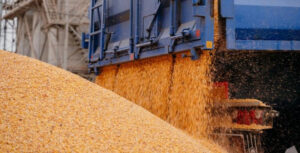
The number of completed movements from Ukraine under the general transit procedure (NCTS) in the first quarter of this year amounted to 19 thousand, which is 13 times more than in the same period last year, the State Customs Service of Ukraine reported on Monday.
“Despite the hostilities and the difficult situation on the western border of Ukraine, the first quarter of 2024 was the most productive by all accounts compared to previous quarters since the start of the application of the common transit procedure (NCTS) in Ukraine, that is, from October 1, 2022,” the agency said in a statement on its Telegram channel.
It is specified that during January-March 2024, a third of the total number of transit declarations under the NCTS was issued – 23.5 thousand out of more than 65 thousand. In particular, in the countries participating in the NCTS Convention, more than 19 thousand movements initiated by the customs authorities of Ukraine were successfully completed, while in Ukraine – almost 4.5 thousand movements initiated in other countries participating in the Convention.
The customs office emphasized that compared to the same period last year, i.e. the first quarter of 2023, the rate of successfully completed movements started in Ukraine increased 13 times, and movements started in other countries party to the Convention – 9 times.
Also, in January-March 2024, the number of companies that received and use authorizations for the application of transit simplifications in accordance with the Convention almost doubled from 57 to 101.
It is specified that they have been granted 121 authorizations (out of 303 during the period of application of the Convention by Ukraine), 39 of which were granted to use the general guarantee (including an increase in the reference amount), 27 each with the status of authorized shipper and consignee, and 22 to use special type seals.
Regarding the guarantee of the joint transit procedure, the State Customs Service notes a significant increase in the number of registered individual guarantees in the first quarter of 2024.
“In this quarter alone, almost 3 thousand individual guarantees worth more than EUR 95 million were registered. At the same time, since Ukraine joined the Convention on the Common Transit Procedure, at the end of the quarter, almost 5.5 thousand valid (including used) individual guarantees totaling EUR 274 million were available in the NCTS system,” the service added.
In addition, during this period, 21 general guarantees worth EUR 38 million were registered. Since the start of the NCTS system, only 74 general guarantees have been registered, 50 of which are currently valid for EUR 167 million.
Earlier, roundtables were devoted to customs reform, where the event’s organizer and moderator Maksim Urakin stated that the State Customs Service accounts for 35-40% of state budget revenues, and these figures have remained stable in recent years. That is why customs reforms are so important for the country.m

Ukrainian and Polish agrarian associations will continue negotiations this week on the transit of grain and other products and the unblocking of the border, said Taras Vysotskyi, First Deputy Minister of Agrarian Policy and Food of Ukraine, during a national telethon.
“It is very important that the associations of different sectors have established communication and will continue to meet this week to clearly agree on the parameters (of export and transit of Ukrainian agricultural products – IF-U). Everyone realized (at the Ukrainian-Polish meeting in Poland last week – IF-U) that interaction and cooperation, agreements will ultimately have the best result,” he said.
According to Vysotsky, in the first two weeks of April, a meeting of the Polish and Ukrainian sides is planned in an expanded format, where farmers of the two countries will look for ways to cooperate. It is expected that this could also become the basis for agreements at the interstate level. Agrarian associations will work on each industry whose representatives were at the talks, including raspberries, juice, honey, eggs, grain, and poultry.
“There is a cautious optimism in this regard, which gives us hope that after a few more meetings to fix the final parameters, we will finally be able to solve this problem,” Vysotsky emphasized.
He also added that the issue of transit of Ukrainian grain is raised at all international meetings.
“Ukraine insists that transit should be available without stops and blockages,” the First Deputy Minister summarized.
agrarian associations, AGRICULTURAL PRODUCTS, BORDER, TRANSIT

In July-September this year, the cargo turnover of the port of Kolobrzeg increased by 52% due to the resumption of transshipment of Ukrainian agricultural products, the Polish edition of Rynek Infrastruktury reports.
According to the report, Kolobrzeg was not previously included in the Polish government’s resolution on the transit of Ukrainian grain. In the third quarter, the port resumed accepting Ukrainian agricultural products, which helped increase cargo turnover.
In the third quarter, the Polish port handled more than 73 thousand tons of cargo, which is 52% more than in the same period of 2022, when 48 thousand tons were handled. The cargo included grain, logs, limestone, pellets and fertilizers. Grain accounts for half of the transshipment. Among the grains transshipped in Kolobrzeg, corn and barley were the most common.
The port temporarily suspended operations in April this year. Back then, the Polish authorities banned imports of Ukrainian grain but allowed its transit. At first, Kolobrzeg was not on the list of ports that could handle Ukrainian grain, but later the Polish government allowed the company to handle Ukrainian cargo.
“We have demonstrated that we are unpredictable in our actions as a country, so building long-term business relations is perceived as risky, as one decree can turn everything upside down”, said Artur Lievski, head of the port’s administration.
A week after the ban was imposed by the Polish government, the mistake was corrected: Kolobrzeg was included in the list of seaports through which grain can be transited from Ukraine. However, it took a long time to restore trust, and for some time no freight trains with Ukrainian products arrived in Kolobrzeg. After a three-month break, the first train with corn from Ukraine arrived at the seaport of Kolobrzeg in late July, the newspaper said.

Lithuania has agreed on a corridor for the transit of Ukrainian grain to Baltic ports, Lithuanian Foreign Minister Gabrielius Landsbergis said.
“Russia destroys food, Lithuania delivers it. A corridor for grain transit to Baltic ports has been approved and agreed upon, which eases pressure on the Ukrainian border and increases supplies to Africa and beyond. Cooperation gives results!” he wrote on Twitter.
Earlier, it was reported that veterinary, sanitary and phytosanitary control would be moved from the Ukrainian-Polish border to the port of Klaipeda (Lithuania) for all agricultural cargoes heading to this port within two days. This will speed up transit through Poland.

Moldova has been offering assistance with the transit of Ukrainian grain since the beginning of the war, and now it is trying to find a solution that will suit Moldovan farmers and help Kiev, Moldovan President Maia Sandu has said.
Speaking about the situation with Ukrainian grain, Sandu called it a “complicated topic.”
“We are trying to find a solution. There are discussions with Ukraine, Romania and the European Commission to see how we can harmonize the interests of Moldovan farmers, but also ensure this transit of grain from Ukraine. We have an obligation to help Ukraine, which today provides for our peace,” she told RFI.
According to her information, Moldova will try to find the best solution for both sides. One of them is rapid investment in transportation and port infrastructure to increase capacity for this period.
“We want to increase our exports, we want to develop our infrastructure, and we can do it, in particular with the resources of the European Union,” she explained.
Sandu spoke about the problem of farmers in Moldova who, even before the war in Ukraine, did not have enough capacity to export.
“We have to state that the railroad and port infrastructure in Moldova is underdeveloped. Now, when these large volumes are coming from Ukraine, the situation has become more complicated,” Sandu said.
As reported, Moldova intends to modernize the railway infrastructure and railway bed in order to increase exports of Ukrainian agricultural goods, for which it cooperates with Romania, Ukraine and donor organizations.

Transit of Ukrainian grain through Poland is steadily growing: if in February it was 114 thousand tons, in June it exceeded 260 thousand tons, Polish Minister of Agriculture and Rural Development Robert Telusz said after online talks on Wednesday with Ukrainian Minister of Agrarian Policy Mykola Solskiy.
“This is very good news for agrarians, because grain from Ukraine does not enter the Polish market,” the Polish minister was quoted as saying in a tweet and on the ministry’s website.
At the same time, he said he saw a chance for the European Commission to extend the decision to ban Ukrainian grain exports to Poland after September 15, blaming both those in power in the EU and the Polish opposition for trying to destabilize Poland.
“It is in our interest to protect the Polish farmer. That is why a clear statement was made by Prime Minister Morawiecki that Ukrainian grain will not enter Poland after September 15,” Telusz reiterated.
According to him, the Polish side wants the so-called “solidarity corridors” to work effectively, which would allow for efficient transportation of Ukrainian goods without harming the Polish agricultural sector.
A press release from the Polish ministry indicates that to this end Telusz proposed measures to facilitate the transit of Ukrainian grain to seaports in various EU countries, in which Solsky was interested, but no other details are available and the Ukrainian ministry has not officially commented on the talks.
The Polish Ministry of Agriculture said that the Ukrainian side will also present a draft of detailed solutions in the near future. “He (Solsky – IF-U) explained that Russian missile strikes on Ukraine’s port infrastructure have put Ukrainian exporters in a very difficult situation. Now they will have to organize grain exports via other routes,” the release said.
Telush informed about ongoing negotiations with Lithuania and Latvia on the use of their ports for grain exports from Ukraine. “These negotiations are going in the right direction,” the minister added.
According to him, Poland has managed to significantly increase grain exports through its four main ports this year. In particular, if in January it amounted to 299 thousand tons, in February – 539 thousand tons, in March – 628 thousand tons, in April – 704 thousand tons, in May – 882 thousand tons, and in June – almost 940 thousand tons.
Poland exported more than 4.5 million tons of crops in 4 months of this year, stated Telusz.
It is noted that the ministers also raised the issue of access of Polish poultry products and eggs to the Ukrainian market, and currently the veterinary services of both countries are working intensively to resolve this issue.
The Polish Ministry of Agriculture pointed out that Ukraine is an important partner of Poland in agri-food trade. In 2022, an increase in agricultural exports to the Ukrainian market by 16% to $945.3 million was recorded. The main export items were: cheese and cottage cheese, products used for animal feed, and coffee. In April 2023, exports of agricultural products to the Ukrainian market increased by more than 35% compared to the same period in 2022, the release added.